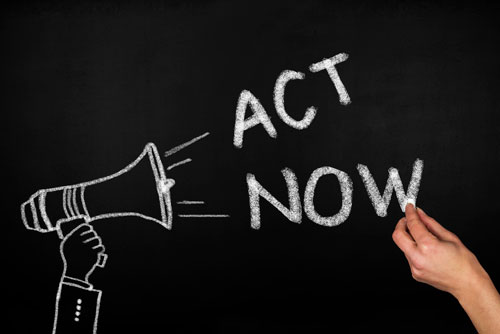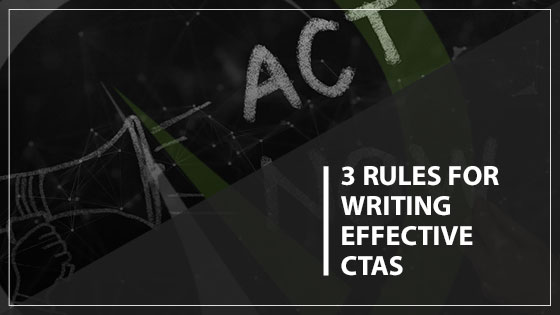The internet is a colossal platform filled with millions of pages of content. When a customer lands on your page, they’re often inclined to immediately move along to the next page unless something catches their eye. A Call-to-Action (CTA) is one of the many devices we use to keep customers engaged with your website longer.
CTAs are short phrases or sentences that invite the customer to act in some way, whether it’s purchasing your product, calling your company, or scheduling an appointment. These phrases are placed strategically throughout your website at the beginning and end of services pages, sprinkled throughout web content, and in standalone buttons.
We’ve found that some CTAs work better than others to engage customers and lead them to act, so we always follow these three rules to write the most effective CTAs.
Rule #1: Use Specific Wording
The best CTAs use very specific wording so that customers know exactly what you are asking them to do. Many CTAs follow the formula:
ACTION VERB + COMPANY + TIME + BENEFIT
An easy example of this formula reads, “Call Joe’s Barbeque today to order your favorite BBQ meal.” The sentence invites the customer to do something, reminds them of the company’s name, gives them a time frame in which to do it, and specifies why they should act. Let’s break down the purpose of each of these components.

1. Action Verb
Using a specific action verb in a CTA is vital to waking up the reader and leading them to engage with your company.
There’s a big difference between the phrases “We offer takeout and delivery” and “Order takeout or delivery.” The first phrase is informative, whereas the second instructs the customer to act. Effective CTAs always include action verbs.
It’s also essential to place the action verb at the beginning of the sentence, as this makes the phrase or sentence read more like a command. Note the difference between “You can hear more about our services if you call us,” and “Call us to hear more about our services.” The first sentence is passive, and the action verb doesn’t stand out. The second sentence makes the call to action clear.
2. Company
The CTA is a great place to remind the reader of your company’s name, location, and phone number. Customers who land on your site may be checking out several companies in the area, so you want your company name to be clear and obvious as they browse your site. Including your contact information makes it that much easier for them to call or visit your business.
3. Time
An equally important aspect of any CTA is time. Using words like “today” or “now” evokes a sense of urgency in the reader and leads them to act immediately, ensuring they take action before they forget. “Call today to schedule an appointment” is a more urgent way to invite them to engage with your company than just saying “Call to schedule an appointment.”
The CTA is also a good place to include any time-sensitive deals the customer should know about. Saying something like “Order today for 50% off your first purchase—this deal ends soon!” increases their sense of urgency. No one wants to miss out on a great deal, and this element could be what pushes them over the edge towards engaging with your company.
4. Benefit
The benefit portion of the CTA reminds the customer why they should act. Why should they call your company? The benefit will likely be explained further on a service page or a blog post but throwing it in the CTA is a good way to remind the reader of the importance of their action. There’s a notable difference between “Call today” and “Call today to schedule an affordable oil change.”

Rule #2: Spice it Up
Writing a basic CTA following the formula above is a great start, but utilizing creative wording takes CTAs to the next level and makes your company stand out. Adding in information about your company’s expertise, your top-level services, or your years of experience further influences the reader to engage.
Saying “Call today to speak with one of our expert plumbers about our premium services” is much more engaging than “Call today to hear about our services.” Including these creative elements in the CTA makes customers even more inclined to choose your business over others.
Rule #3: Remove the Risk
The last step in crafting the perfect CTA is to remove any risk that customers might feel engaging with your company. Some people may be hesitant to schedule a repair estimate if they think they will be roped into paying for it, so your CTA could be something like “Schedule a repair estimate today—it’s absolutely free!”
Overall, a well-crafted CTA encourages your readers to engage with your company and, ultimately, purchase your services or products. Gauge Digital Media will craft effective CTAs for your website—call today at (410) 376-7709 to hear more about our Search Engine Optimization services! (See what we did there?)






